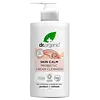What's inside
What's inside
 Key Ingredients
Key Ingredients

 Benefits
Benefits

 Concerns
Concerns

 Ingredients Side-by-side
Ingredients Side-by-side

Water
Skin ConditioningIsododecane
EmollientPropylene Glycol Dicaprylate/Dicaprate
EmollientGlycerin
HumectantEthylhexyl Isononanoate
EmollientButylene Glycol
HumectantGlyceryl Stearate Se
EmulsifyingPEG-100 Stearate
Triundecanoin
Skin ConditioningCetyl Alcohol
EmollientOctyldodecanol
EmollientStearyl Alcohol
EmollientGluconolactone
Skin ConditioningCetearyl Glucoside
EmulsifyingCucumis Sativus Fruit Extract
EmollientAloe Barbadensis Leaf Juice
Skin ConditioningAlthaea Officinalis Root Extract
Skin ConditioningChamomilla Recutita Flower Extract
MaskingRosmarinus Officinalis Leaf Extract
AntimicrobialCetearyl Alcohol
EmollientDimethicone
EmollientC13-14 Isoparaffin
EmollientPropylene Glycol
HumectantLaureth-7
EmulsifyingPolyacrylamide
Disodium EDTA
Chlorphenesin
AntimicrobialMethylparaben
PreservativeParfum
MaskingBenzyl Benzoate
AntimicrobialWater, Isododecane, Propylene Glycol Dicaprylate/Dicaprate, Glycerin, Ethylhexyl Isononanoate, Butylene Glycol, Glyceryl Stearate Se, PEG-100 Stearate, Triundecanoin, Cetyl Alcohol, Octyldodecanol, Stearyl Alcohol, Gluconolactone, Cetearyl Glucoside, Cucumis Sativus Fruit Extract, Aloe Barbadensis Leaf Juice, Althaea Officinalis Root Extract, Chamomilla Recutita Flower Extract, Rosmarinus Officinalis Leaf Extract, Cetearyl Alcohol, Dimethicone, C13-14 Isoparaffin, Propylene Glycol, Laureth-7, Polyacrylamide, Disodium EDTA, Chlorphenesin, Methylparaben, Parfum, Benzyl Benzoate
Water
Skin ConditioningAloe Barbadensis Leaf Juice Powder
Skin ConditioningCoco-Glucoside
CleansingCaprylic/Capric Triglyceride
MaskingGlyceryl Stearate Se
EmulsifyingGlycerin
HumectantCetearyl Alcohol
EmollientHelianthus Annuus Seed Oil
EmollientLactobacillus Ferment Lysate
Skin ConditioningLactobacillus Ferment
Skin ConditioningAlpha-Glucan Oligosaccharide
CleansingInulin
Skin ConditioningAnthemis Nobilis Flower Oil
MaskingCamellia Sinensis Leaf Extract
AntimicrobialPunica Granatum Extract
AstringentGluconolactone
Skin ConditioningArginine
MaskingTocopherol
AntioxidantCaffeine
Skin ConditioningCalcium Gluconate
HumectantSodium Stearoyl Glutamate
CleansingXanthan Gum
EmulsifyingCitric Acid
BufferingDehydroacetic Acid
PreservativeBenzyl Alcohol
PerfumingSodium Benzoate
MaskingWater, Aloe Barbadensis Leaf Juice Powder, Coco-Glucoside, Caprylic/Capric Triglyceride, Glyceryl Stearate Se, Glycerin, Cetearyl Alcohol, Helianthus Annuus Seed Oil, Lactobacillus Ferment Lysate, Lactobacillus Ferment, Alpha-Glucan Oligosaccharide, Inulin, Anthemis Nobilis Flower Oil, Camellia Sinensis Leaf Extract, Punica Granatum Extract, Gluconolactone, Arginine, Tocopherol, Caffeine, Calcium Gluconate, Sodium Stearoyl Glutamate, Xanthan Gum, Citric Acid, Dehydroacetic Acid, Benzyl Alcohol, Sodium Benzoate
Ingredients Explained
These ingredients are found in both products.
Ingredients higher up in an ingredient list are typically present in a larger amount.
Cetearyl alcohol is a mixture of two fatty alcohols: cetyl alcohol and stearyl alcohol. It is mainly used as an emulsifier. Emulsifiers help prevent the separation of oils and products. Due to its composition, it can also be used to thicken a product or help create foam.
Cetearyl alcohol is an emollient. Emollients help soothe and hydrate the skin by trapping moisture.
Studies show Cetearyl alcohol is non-toxic and non-irritating. The FDA allows products labeled "alcohol-free" to have fatty alcohols.
This ingredient is usually derived from plant oils such as palm, vegetable, or coconut oils. There is debate on whether this ingredient will cause acne.
Due to the fatty acid base, this ingredient may not be Malassezia folliculitis safe.
Learn more about Cetearyl AlcoholGluconolactone is a PHA. PHAs are a great gentle alternative to traditional AHAs.
When applied, Gluconolactone has the same affect on skin as AHAs such as lactic acid. It helps dissolve the dead skin cells in the top layer of your skin. This improves texture and brightens the skin.
PHAs are more gentle than AHAs due to their larger structure. They do not penetrate as deeply as AHAs and take a longer time to dissolve dead cells. Studies show PHAs do not cause as much irritation.
Gluconolactone has some interesting properties:
In a 2004 study, Gluconolactone was found to prevent UV damage in mouse skin cells and has not been found to increase sun sensitivity. However, we still recommend wearing SPF daily.
This ingredient is is an created by reacting gluconic acid with an alcohol.
Learn more about GluconolactoneGlycerin is already naturally found in your skin. It helps moisturize and protect your skin.
A study from 2016 found glycerin to be more effective as a humectant than AHAs and hyaluronic acid.
As a humectant, it helps the skin stay hydrated by pulling moisture to your skin. The low molecular weight of glycerin allows it to pull moisture into the deeper layers of your skin.
Hydrated skin improves your skin barrier; Your skin barrier helps protect against irritants and bacteria.
Glycerin has also been found to have antimicrobial and antiviral properties. Due to these properties, glycerin is often used in wound and burn treatments.
In cosmetics, glycerin is usually derived from plants such as soybean or palm. However, it can also be sourced from animals, such as tallow or animal fat.
This ingredient is organic, colorless, odorless, and non-toxic.
Glycerin is the name for this ingredient in American English. British English uses Glycerol/Glycerine.
Learn more about GlycerinGlyceryl Stearate Se is a self-emulsifying (SE) form of glyceryl stearate. Self-emusifying means this ingredient automatically blends with water. It is an emulsifier, emollient, and cleansing agent.
As an emulsifier, Glyceryl Stearate Se prevents ingredients such as oil and water from separating. It is also a surfactant, meaning it helps cleanse the skin. Surfactants help gather oil, dirt, and other pollutants so they may be rinsed away easily.
Emollients help your skin stay smooth and soft. It does so by creating a film on top of the skin that helps trap moisture in.
Learn more about Glyceryl Stearate SeWater. It's the most common cosmetic ingredient of all. You'll usually see it at the top of ingredient lists, meaning that it makes up the largest part of the product.
So why is it so popular? Water most often acts as a solvent - this means that it helps dissolve other ingredients into the formulation.
You'll also recognize water as that liquid we all need to stay alive. If you see this, drink a glass of water. Stay hydrated!
Learn more about Water